Bed for Chesapeake Bay Retriever
The Chessie’s Like A Good Bed!
Introduction
The Bed for Chesapeake Bay Retriever takes into account their health conditions, sleeping style, and preferences. An orthopedic bed makes the best choice.
The Chesapeake Bay Retriever, affectionately known as the “Chessie,” is a unique and distinguished breed, originally bred for the cold, rugged waters of the Chesapeake Bay region in the United States. Known for their strength, endurance, and unwavering loyalty, Chessie’s have earned a reputation as one of the most resilient and hardworking retrievers.
Unlike their more popular retriever cousins, such as the Labrador and Golden Retriever, Chesapeake Bay Retrievers are known for their independence, protective nature, and strong-willed personalities. These traits, along with their excellent swimming abilities and powerful retrieving instinct, make them exceptional hunting companions and loyal family pets.
However, the Chessie’s unique combination of traits can pose challenges for first-time owners or those unfamiliar with the breed’s needs. This breed requires consistent training, ample exercise, and early socialization to thrive.
Their protective instincts and independent nature mean they may not be as immediately friendly or eager to please as other retrievers, but with the right guidance, they become devoted and loving companions.
Understanding the breed’s characteristics, health needs, and behavioral tendencies is essential for anyone considering bringing a Chesapeake Bay Retriever into their home. By doing so, owners can build a strong, lasting bond with this intelligent and versatile breed, ensuring a happy and balanced relationship.
Whether for hunting, companionship, or dog sports, Chessie’s excel in any task that allows them to demonstrate their impressive skills and deep loyalty.
In this guide we share information for new owners to be aware of. The topics include best dog bed types, brands, facts, fun facts, health conditions, behavior concerns, tips for new owners, costs of ownership, and safe foods and foods to avoid.
Video: Pros & Cons Chesapeake Bay Retriever
In this video is shared the pros and cons of Chesapeake Bay Retriever ownership. If you are a potential new owner take a look at the video to determine if you want to own one of these dogs.
Best Dog Bed Types & Brands
Chesapeake Bay Retrievers are active, large dogs that need a durable and comfortable bed to support their joints and help them relax after a long day of exercise.
When choosing a bed for a Chessie, consider factors such as their size, durability, support for joints (especially for older dogs), and ease of cleaning.
Here’s a list of the best types of dog beds and some recommended brands for new Chesapeake Bay Retriever owners.
Best Dog Bed Types for Chesapeake Bay Retrievers:
-
Orthopedic Beds:
- Chesapeake Bay Retrievers are prone to joint issues like hip dysplasia, so orthopedic beds with memory foam are ideal, especially for older dogs or those prone to joint problems.
- Best For: Joint support, comfort for aging dogs, long-lasting durability.
- CertiPUR-US Seal: When shopping for a memory foam bed be sure to look for the CertiPUR-US seal. The seal means that the materials used do not contain any toxins or chemicals that are harmful to pets and humans.
- Waterproof or Water-Resistant Beds:
- Chessie’s love water and are often wet after swimming or playing outdoors, so a waterproof or water-resistant bed is a practical choice. These beds are easy to clean and prevent moisture from seeping into the material.
- Best For: Dogs who love water or tend to get wet frequently.
- Chew-Resistant Beds:
- Chesapeake Bay Retrievers can be heavy chewers, especially when they’re young. A chew-resistant bed with durable fabric is a good investment to prevent destruction.
- Best For: Strong chewers or young puppies going through teething.
- Elevated (Cot-Style) Beds:
- These beds keep dogs off the ground, which can be great for air circulation and keeping them cool. Elevated beds are also durable and easy to clean.
- Best For: Outdoor use, dogs that like to stay cool, and easy cleaning.
- Cooling Beds:
- For dogs that tend to overheat, especially after exercise, cooling beds help regulate body temperature. Some beds come with a cooling gel layer or airflow design.
- Best For: Active dogs or those in warm climates.
- Bolster Beds:
- Bolster beds with raised edges provide a sense of security for dogs that like to curl up, while still offering a soft, supportive cushion.
- Best For: Dogs who prefer to curl up or lean against something.
Recommended Dog Bed Brands for Chesapeake Bay Retrievers:
- Big Barker:
- Specializes in orthopedic beds for large dogs. Their beds are made with high-quality memory foam to support joints and provide maximum comfort.
- Best For: Large dogs with joint issues, long-lasting durability.
- Product: Big Barker 7″ Pillow Top Orthopedic Dog Bed.
- K9 Ballistics:
- Known for chew-resistant and durable beds, K9 Ballistics offers beds that stand up to rough treatment while still being comfortable for dogs.
- Best For: Dogs that chew or scratch at their bed.
- Product: K9 Ballistics Chew Proof Elevated Dog Bed.
- Kuranda:
- A popular brand for elevated dog beds, which are great for dogs who like to stay cool or need an easy-to-clean option.
- Best For: Outdoor use, cooling, and easy maintenance.
- Product: Kuranda Chewproof Elevated Dog Bed.
- PetFusion:
- PetFusion offers orthopedic beds with memory foam, which are perfect for large dogs like Chessie’s. Their beds are also water-resistant and have washable covers.
- Best For: Comfort and easy maintenance.
- Product: PetFusion Ultimate Orthopedic Dog Bed.
- The Dog’s Bed:
- Offers a range of orthopedic memory foam beds that provide great support for large dogs, especially those with arthritis or hip dysplasia.
- Best For: Aging dogs or those with joint problems.
- Product: The Dog’s Bed Orthopedic Memory Foam Dog Bed.
- Coolaroo:
- Known for their elevated beds, Coolaroo offers a breathable mesh fabric that’s perfect for dogs who need to stay cool, particularly after exercise or in warmer climates.
- Best For: Keeping dogs cool and comfortable outdoors.
- Product: Coolaroo Elevated Pet Bed.
Facts and Fun Facts About Chesapeake Bay Retrievers
Measurements:
- Size: Medium to Large
- Group: Sporting Group
- Height Male: 23 -26 inches
- Height Female: 21 – 24 inches
- Weight Male: 65 – 80 lbs.
- Weight Female: 55 – 70 lbs.
- Length: 31 – 37 inches
- Lifespan: 10 -13 years
- Fully Grown: 12 – 18 months
- Colors: Brown, Dark Brown, Dark Deadgrass, Deadgrass, Light Brown, Light Deadgrass, Sedge, & Tan
- Popularity: This breed is the 54th most popular in the United States according to the American Kennel Club in 2023.
- Intelligence: This breed is ranked the 27th most intelligent according to Professor Stanley Coren at the University of British Columbia.
Here are some facts and fun facts about the Chesapeake Bay Retriever!
Facts:
- Origin: Chesapeake Bay Retrievers, also known as “Chessie’s,” originated in the U.S. around the Chesapeake Bay region in the early 19th century.
- Purpose: They were bred primarily as waterfowl retrievers, designed for retrieving ducks from cold waters.
- Coat: Chessie’s have a dense, water-resistant double coat that helps them endure icy waters and cold climates.
- Colors: Their coat can be shades of brown, sedge (reddish), or deadgrass (straw-colored).
- Temperament: They are known for their loyalty, intelligence, and strong work ethic.
- Energy Level: Chessie’s are high-energy dogs that need plenty of exercise, especially in outdoor and water activities.
- Lifespan: Their average lifespan is around 10–13 years.
- Training: Chesapeake Bay Retrievers are intelligent but can be independent, so early training and socialization are essential.
- Guarding Instincts: Unlike other retrievers, Chessie’s can be protective and wary of strangers, making them good guard dogs.
- Webbed Feet: Their webbed feet make them excellent swimmers, and they can work in tough water conditions.
- Health: Common health issues include hip dysplasia, progressive retinal atrophy (PRA), and elbow dysplasia.
Fun Facts:
- Duck Dynasty: Chessie’s can retrieve up to 100 ducks a day in freezing waters, a testament to their stamina and strength.
- First Love: The breed’s foundation started with two Newfoundland puppies, rescued from a sinking ship in 1807 off the coast of Maryland.
- Tough Dogs: Chessie’s are known to break through ice to retrieve ducks, showing their exceptional toughness.
- Distinctive Smile: Some Chessie’s are known to “smile” by showing their front teeth in a non-aggressive way.
- Versatile Dogs: While bred for retrieving, they also excel in search and rescue, therapy, and competitive dog sports.
- Unique Coat Maintenance: Their oily, water-resistant coat doesn’t require much grooming, but Chessie’s rarely need baths, as it strips away the natural oils.
- Independent Streak: They are one of the more independent retriever breeds, with a mind of their own, making them more challenging to train than a Labrador.
- Chessie Motto: Owners often joke that their Chessie’s motto is, “I’ll get it done…in my own time.”
- Presidential Pooch: General George Custer and President Theodore Roosevelt owned Chessie’s, showing their popularity among historical figures.
- Strong Bond: They form a strong bond with their families, often being a one-family or one-person dog, unlike many other retriever breeds.
- Great with Kids: Despite their protective nature, Chessie’s are known to be very good with children in the family.
- Multi-Purpose Dog: In addition to retrieving, they have been used for tracking, hunting upland game, and even pulling fishing nets!
Health Conditions
Chesapeake Bay Retrievers are generally healthy, but like many purebred dogs, they can be prone to certain genetic or breed-specific conditions. Here’s a list of the most common health issues Chessie’s may face: Most Common Health Conditions in Chesapeake Bay Retrievers:
- Hip Dysplasia: A common genetic condition where the hip joint doesn’t fit properly into the socket, leading to arthritis or pain.
- Elbow Dysplasia: Another joint-related issue that can cause arthritis or lameness in the front legs due to abnormal development of the elbow joint.
- Progressive Retinal Atrophy (PRA): A degenerative eye condition that leads to blindness over time.
- Entropion: A condition where the eyelid rolls inward, causing the eyelashes to irritate the eye, which can lead to infections or corneal damage.
- Gastric Dilatation-Volvulus (Bloat): A life-threatening condition where the stomach fills with gas and twists, cutting off blood supply to vital organs.
- Hypothyroidism: A disorder where the thyroid gland doesn’t produce enough hormones, leading to weight gain, lethargy, and coat problems.
- Osteochondrosis Dissecans (OCD): A joint disorder where cartilage separates from the bone, usually affecting shoulders, elbows, or knees.
- Degenerative Myelopathy (DM): A progressive disease of the spinal cord that leads to hind limb weakness and paralysis.
- Exercise-Induced Collapse (EIC): A genetic condition that causes sudden collapse during intense exercise or excitement.
- Cataracts: Cloudiness in the lens of the eye, which can lead to vision impairment or blindness, typically seen in older dogs.
- Ear Infections: Due to their love of water, Chessie’s can be prone to ear infections if their ears aren’t kept clean and dry after swimming.
- Epilepsy: A neurological disorder that can cause seizures, which can vary in frequency and severity.
Routine checkups and health screenings can help manage or prevent some of these conditions.
Behavior Concerns
Chesapeake Bay Retrievers have a unique set of behaviors and personality traits that set them apart from other retriever breeds. Here’s a list of common behaviors new owners should be aware of:
Common Behaviors in Chesapeake Bay Retrievers:
- Strong Work Ethic: Chessie’s are bred to work, and they thrive in active environments where they have a job to do, whether it’s retrieving, hunting, or other tasks.
- Independence: Unlike other retrievers that may be more eager to please, Chessie’s can be independent and have a mind of their own, which can make training more challenging.
- Protectiveness: Chesapeake Bay Retrievers tend to be more protective of their family and home than many other retriever breeds. They can be wary of strangers, making them good watchdogs.
- Loyalty: They form strong bonds with their families, often becoming a “one-person” dog, where they focus on and are most attached to one individual.
- Stubbornness: Chessie’s can be stubborn, so consistent training with firm but fair leadership is essential. They may choose to obey only if they see the purpose behind the command.
- High Energy: This breed has a lot of energy and needs plenty of exercise to stay happy and healthy. Long walks, runs, swimming, or interactive play are crucial.
- Love of Water: Chessie’s love swimming and being near water. They were bred for retrieving waterfowl, so they are naturally drawn to lakes, rivers, and ponds.
- Strong Retrieving Instinct: Their retrieving instinct is deeply ingrained, so they often enjoy games like fetch, especially in water. They may try to retrieve objects even when not instructed.
- Intelligence: Chesapeake Bay Retrievers are highly intelligent and can excel in tasks that require problem-solving. However, their intelligence can also lead to boredom if not mentally stimulated.
- Territorial Nature: They can be territorial, especially around their home or yard, and may be more prone to bark when they perceive a threat.
- Moderate Socialization Needs: Early and regular socialization is important to prevent Chessie’s from becoming too aloof or overly protective. Without it, they can be reserved or even aggressive towards unfamiliar people or animals.
- Food-Motivated: While independent, they can be highly motivated by food rewards, which can be a useful tool in training. However, owners need to monitor their diet to avoid weight gain.
Understanding these behaviors can help new owners effectively train and bond with their Chesapeake Bay Retriever, ensuring a happy and balanced relationship.
Tips for New Owners
Here are some key tips for new Chesapeake Bay Retriever owners to raise a happy, healthy, and well-behaved dog:
Tips for New Chesapeake Bay Retriever Owners:
- Start Early Socialization: Socialize your Chessie from an early age with people, other dogs, and different environments. This helps curb their natural wariness of strangers and prevents territorial or aggressive behavior later in life.
- Consistent and Firm Training: Chessie’s are independent and strong-willed, so it’s important to establish firm but fair leadership. Use positive reinforcement, but be consistent with rules and commands, as they can sometimes be stubborn.
- Focus on Obedience Training: Basic obedience training is crucial, especially focusing on commands like “stay” and “come,” which help control their independent nature. This training should start young and continue into adulthood.
- Exercise is Essential: Chessie’s are high-energy dogs and need plenty of physical activity to stay happy. Regular walks, running, swimming, and games of fetch are great outlets for their energy. Plan on at least an hour of vigorous exercise daily.
- Provide Mental Stimulation: These intelligent dogs can become bored easily. Engage them in activities that challenge their minds, such as puzzle toys, interactive games, or learning new tricks. Consider activities like scent work, agility, or dock diving.
- Introduce Water Early: Chesapeake Bay Retrievers are natural water dogs. If possible, introduce them to swimming at a young age in a safe environment. Swimming is an excellent way to give them exercise and playtime.
- Watch for Protective Behavior: Chessie’s can be naturally protective of their family and home. While this makes them excellent watchdogs, new owners should monitor their protectiveness to ensure it doesn’t turn into excessive guarding or aggression.
- Crate Train for Structure: Crate training provides Chessie’s with a safe space and helps with house training. It also gives them a calm environment where they can relax and decompress, which is especially important in a busy household.
- Groom Their Coat Properly: While Chessie’s have a relatively low-maintenance coat, it is water-resistant and can become oily. Brush their coat regularly but avoid frequent baths, as it strips away the oils that protect their skin and fur.
- Monitor Their Diet: Chessie’s love food and can gain weight if overfed. Feed them a high-quality, balanced diet, and be mindful of their portion sizes, especially if you’re using treats for training.
- Regular Vet Check-ups and Screenings: Stay on top of regular veterinary visits and consider screening for common health issues like hip dysplasia and eye conditions. Early detection can help manage or prevent serious health problems.
- Patience and Persistence: Raising a Chesapeake Bay Retriever requires patience and persistence. They are not always as easygoing as some other retriever breeds, but with the right guidance, they can become incredibly loyal and well-behaved companions.
These tips will help new owners understand and care for the breed’s unique needs, ensuring they build a strong, healthy, and rewarding relationship with their Chesapeake Bay Retriever.
Costs of Ownership
Here’s a breakdown of the average costs associated with owning a Chesapeake Bay Retriever. These costs will vary depending on location, the quality of services, and the dog’s specific needs, but this gives a general idea on how to plan your budget.
1. Initial Costs:
- Purchase Price or Adoption Fee:
- From a breeder: $800 – $2,500 (depending on bloodline, breeder reputation, and location).
- Adoption fee: $100 – $500 (if adopting from a shelter or rescue).
- Initial Veterinary Costs (vaccinations, spaying/neutering, health checks): $200 – $500.
- Microchipping: $25 – $50.
- Dog Crate: $50 – $150.
- Dog Bed: $30 – $100.
- Collar, Leash, and ID Tags: $30 – $50.
- Toys and Chews: $25 – $75.
2. Monthly or Recurring Costs:
- Food:
- High-quality dog food: $50 – $100 per month (varies based on the brand and portion size).
- Treats and Chews: $10 – $30 per month.
- Grooming Supplies (brushes, shampoo, etc.): $10 – $20 per month (if grooming yourself).
- Routine Veterinary Care (checkups, vaccinations, flea/tick prevention): $50 – $100 per month.
- Pet Insurance: $30 – $50 per month (varies by coverage).
- Training Classes (if needed): $100 – $300 for a 6-8 week course.
- Toys and Enrichment: $10 – $20 per month to replace or add new items.
3. Annual Costs:
- Veterinary Checkups and Vaccinations: $200 – $400 per year (routine care).
- Heartworm, Flea, and Tick Prevention: $150 – $300 per year.
- Dental Care: $100 – $300 per year (cleanings or dental products).
4. Other Potential Costs:
- Grooming: Chessie’s don’t require frequent professional grooming, but occasional services may cost around $50 – $80 per session.
- Boarding or Pet Sitting: $20 – $50 per day when you’re away.
- Dog Walking Services: $15 – $30 per walk (if you need to hire a dog walker).
- Health Testing (if done for breeding purposes or health screenings): $100 – $500 depending on the tests.
- Training (advanced/behavioral): $50 – $100 per session with a professional trainer.
- Emergency Vet Care: $500 – $3,000 (in case of accidents or serious health issues).
- Estimated First-Year Cost: $1,500 – $4,000 (includes purchase price, initial supplies, vet care, food, etc.)
- Estimated Annual Cost (after the first year): $1,000 – $2,500 (for food, vet care, supplies, etc.)
Owning a Chesapeake Bay Retriever is an investment, and proper budgeting ensures they get the care, exercise, and attention they need to thrive.
Safe Foods & Foods to Avoid
Here’s a list of safe foods for Chesapeake Bay Retrievers and foods to avoid ensuring their health and well-being:
Safe Foods for Chesapeake Bay Retrievers:
- Lean Meats:
- Chicken, turkey, and lean cuts of beef or lamb (cooked and unseasoned).
- Avoid bones in cooked meat, as they can splinter.
- Fish:
- Salmon and sardines (rich in omega-3 fatty acids).
- Ensure the fish is cooked, boneless, and without seasoning.
- Vegetables:
- Carrots, sweet potatoes, green beans, and peas (cooked or raw).
- Pumpkin (good for digestion in moderation).
- Broccoli and spinach (small quantities).
- Fruits:
- Apples (without seeds or core), blueberries, bananas, strawberries, and watermelon.
- These are safe, but should be given in moderation due to sugar content.
- Eggs:
- Cooked eggs are a great source of protein. Avoid raw eggs, as they may carry bacteria like salmonella.
- Plain Rice and Pasta:
- Great as a filler in moderation, especially if your dog has an upset stomach.
- Peanut Butter:
- In small amounts, and make sure it does not contain xylitol, which is toxic to dogs.
- Oats and Quinoa:
- Oats and quinoa are healthy grains for dogs in moderation.
- Yogurt (Plain and Unsweetened):
- A good source of calcium and probiotics. Avoid flavored or sweetened varieties.
- Cottage Cheese:
- In small amounts, it’s a good source of protein and calcium.
- Coconut Oil:
- Can be added in small amounts to help with coat health and digestion.
- Bone Broth:
- A nutritious liquid to mix with food, as long as it’s free from onions and garlic.
Foods to Avoid for Chesapeake Bay Retrievers:
- Chocolate:
- Contains theobromine, which is toxic to dogs and can cause vomiting, diarrhea, rapid heart rate, and even death.
- Grapes and Raisins:
- Highly toxic and can cause kidney failure, even in small amounts.
- Onions and Garlic:
- Can cause damage to red blood cells, leading to anemia. Even in powdered form, these are dangerous.
- Alcohol:
- Can lead to severe liver and kidney damage, even in small amounts.
- Avocado:
- Contains persin, which can cause vomiting and diarrhea in dogs.
- Macadamia Nuts:
- Highly toxic to dogs and can cause weakness, tremors, and hyperthermia.
- Xylitol (Artificial Sweetener):
- Found in sugar-free gum, candies, and some peanut butter brands. It causes insulin release, leading to low blood sugar, seizures, and liver failure.
- Cooked Bones:
- While raw bones can sometimes be safe, cooked bones can splinter and cause choking, blockages, or tears in the digestive system.
- Caffeine (Coffee, Tea, etc.):
- Caffeine is toxic and can cause restlessness, rapid breathing, heart palpitations, and muscle tremors.
- Dairy Products (in large quantities):
- Many dogs are lactose intolerant, so too much cheese, milk, or ice cream can cause digestive upset.
- Raw Dough:
- Yeast dough can expand in your dog’s stomach, causing bloating and potentially life-threatening issues.
- Fat Trimmings and Greasy Foods:
- High-fat foods can lead to pancreatitis, an inflammatory condition that is painful and potentially dangerous.
By feeding your Chesapeake Bay Retriever safe, nutritious foods and avoiding harmful ingredients, you help ensure they stay healthy and happy!
Conclusion
Owning a Chesapeake Bay Retriever is a rewarding experience, but it comes with a unique set of challenges that require commitment, patience, and understanding. This breed, with its strong work ethic, independent nature, and protective instincts, is not your typical retriever.
Chessie’s need more than just basic care and affection; they require a purpose, whether it’s in the form of hunting, dog sports, or simply engaging with their families through mental and physical activities.
With proper training and guidance, Chesapeake Bay Retrievers become exceptional companions, offering unmatched loyalty and a bond that can last a lifetime.
New owners should be prepared for a dog that may not always be eager to follow commands right away. Chessie’s think for themselves, and their intelligence often manifests in a desire to do things their way.
However, this trait is not a flaw but a reflection of their breeding history—designed to work independently in challenging conditions. Once owners understand this, they can approach training with consistency and positive reinforcement, making tasks more of a partnership than a one-sided order.
In terms of health, early prevention and regular veterinary checkups are essential for keeping Chessie’s in good shape, as they can be prone to certain genetic conditions like hip dysplasia or progressive retinal atrophy.
A balanced diet, regular exercise, and proper grooming can go a long way in ensuring their well-being. For those ready to take on the commitment, Chesapeake Bay Retrievers offer a rare combination of strength, resilience, and affectionate companionship.
They are not just working dogs but also devoted family members who will protect and love their people fiercely. In the right home, with an active lifestyle and plenty of opportunities to exercise their mind and body, Chessie’s can truly thrive and bring immense joy to their owners.
By respecting their unique traits and providing the structure they need, you can enjoy a fulfilling relationship with this remarkable breed.
You can check out the other dog breed information by clicking HERE!
Shop Dog Beds
Shop dog beds for your dog by selecting or clicking on any bed of choice. You will be taken to Amazon where you can read customer reviews and answered questions and place the order.
As an Amazon Associate, I earn from qualifying purchases. Your purchase price is the same as if you shop directly on Amazon.
The price at time of publish is included below to give you an idea of what the price is; however, it is subject to change.
Shop Rectangle Dog Beds

Laifug Large Grey Orthopedic Rectangle Bed
Price At Time of Publish $130.00
Laifug Large Blue Orthopedic Rectangle Bed
Price At Time of Publish $130.00 $110.00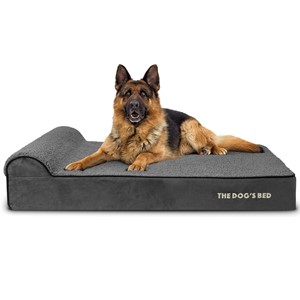
The Dogs Bed XL Grey Orthopedic Rectangle Bed
Price At Time of Publish $130.00 $185.00

KOPEKS Jumbo Orthopedic Rectangular Bed
Price At Time of Publish $130.00 $110.00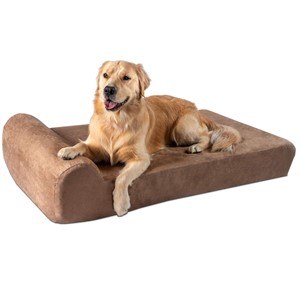
Big Barker XL Orthopedic Rectangle Bed
Price At Time of Publish $130.00 $240.00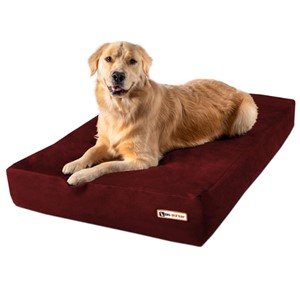
Big Barker XL Burgundy Orthopedic Rectangle Bed
Price At Time of Publish $130.00 $200.00

Serta XL Brown Orthopedic Rectangle Bed
Price At Time of Publish $130.00 $80.00
DogBed4Less XL Blue Orthopedic Rectangle Bed
Price At Time of Publish $130.00 $80.00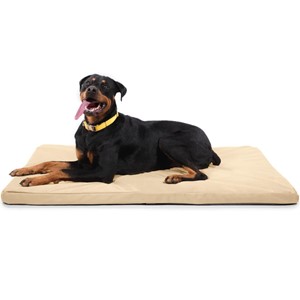
K9 Ballistics XL Sandstone Orthopedic Crate Pad
Price At Time of Publish $130.00 $159.00
Shop Bolster Dog Beds

Brindle XL Gray Orthopedic Bolster Bed
Price At Time of Publish $130.00 $79.00
Bedsure XL Blue Orthopedic Bolster Bed
Price At Time of Publish $130.00 $76.00
Bedsure XL Grey Orthopedic Bolster Bed
Price At Time of Publish $130.00 $60.00
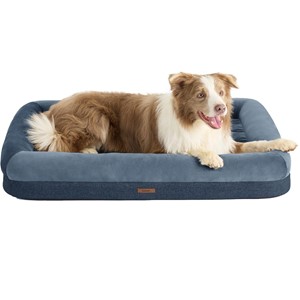
Lesure XL Navy Orthopedic Bolster Bed
Price At Time of Publish $130.00 $40.00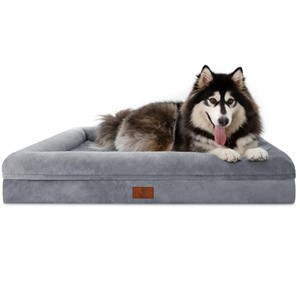
Yiruka XL Grey Orthopedic Bolster Bed
Price At Time of Publish $130.00 $55.00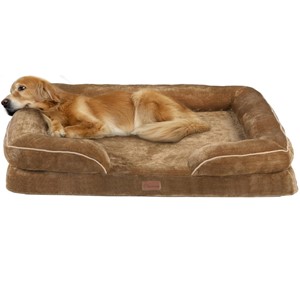
Yitahome XL Brown Orthopedic Bolster Bed
Price At Time of Publish $130.00 $37.00
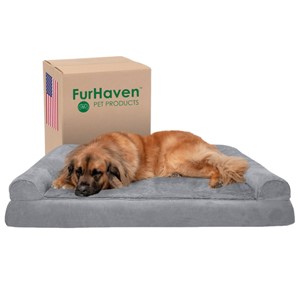
Furhaven XL Gray Orthopedic Bolster Bed
Price At Time of Publish $130.00 $130.00
PetFusion XL Grey Orthopedic Bolster Bed
Price At Time of Publish $130.00 $60.00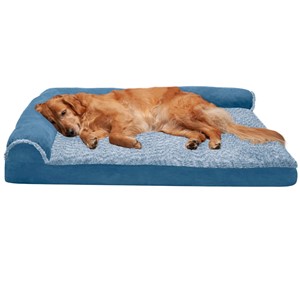
Furhaven Jumbo Blue Orthopedic Bolster Bed
Price At Time of Publish $130.00 $60.00
Shop Elevated Dog Beds
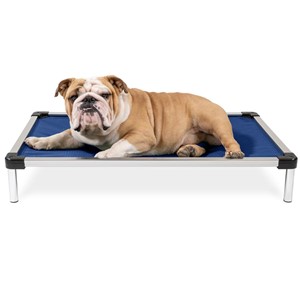
K9 Ballistics Chew Proof Elevated Small Bed
Price At Time of Publish $130.00 $129.00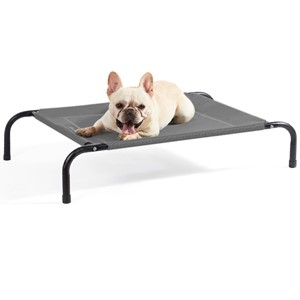
Bedsure Medium Elevated Dog Bed
Price At Time of Publish $130.00 $33.00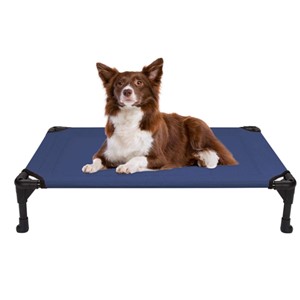
Veehoo Medium Elevated Dog Bed
Price At Time of Publish $130.00 $45.00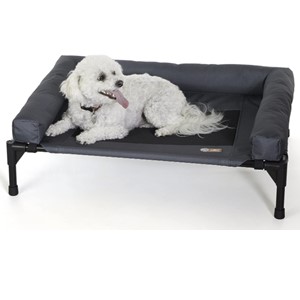
K&H Pet Products Elevated Bolster Dog Bed
Price At Time of Publish $130.00 $57.00
Kuranda Elevated Chew Proof Small Dog Bed
Price At Time of Publish $130.00 $134.00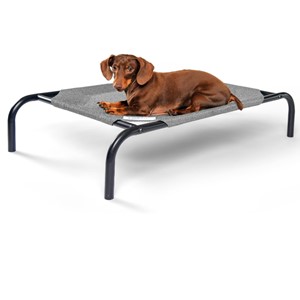
Coolaroo Small Elevated Dog Bed
Price At Time of Publish $130.00 $21.00
Related Articles
Below are some other articles you may be interested in reading. Just select on the topic of interest to learn more about it.
- Best Healthy Dog Food Brands
- Christmas Presents for My Dog
- Crates for Dogs
- Critical Signs Your Dog Needs Help
- Dog Training Techniques
- How To Train a Puppy
- Positive Reinforcement for Dog Training
- Puppy Proofing Your House
- Training Dog with Treats
- Using Alexa for Dog Behaviors
Go back to the Dog Luxury Beds home page.

